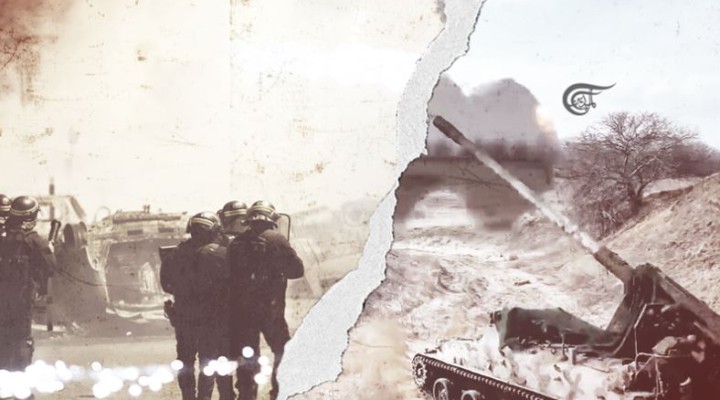Indecision Haunts the West: Events on the Ukraine Front Sends It Reeling

The western Intelligence community was already reeling from the videos of Ukraine’s NATO-supplied, burnt-out ‘armoured fists’ – when the Prigozhin débacle hit.
We are — for the moment — in the hanging void between events. The chaos that Western MSM was expecting (“with libidinous excitement”) to unfold in Russia did arrive, except that it exploded in France, where it was not expected — and with Macron on the ropes, rather than Putin, in Moscow. Indeed, there is much to be distilled from this interesting inversion of expectations and of events.
If the failure of Russia to descend into French-style chaos as a result of the Prigozhin ‘mutiny’ represents the initial ‘bookend’ to the present directionless void, the other bookend is, (or is supposed to be), the NATO summit beginning on 11 July in Vilnius, at which a new western ‘direction’ for Ukraine’s future is to be officially promulgated (though any consensus on the future looks very shaky, at this point).
Reports suggest that western Intelligence was thrown into confusion as the Prigozhin march on Moscow faded within hours, only to emerge as a negotiated settlement, and (puzzlingly for the analysts) to quiet across Russia. They couldn’t figure it out: What was going on? Was Prigozhin for real, or was it all some complicated chess game that was unfolding before their eyes?
So, for now (pending final clarification at the Vilnius summit), US commentators have (with some honourable exceptions) all pushed the ‘default button’: ‘Freeze the conflict, as is’ — then Biden and US military doctrine might be spared humiliation. And, more saliently, temporarily spare NATO the key question: Is it ‘fit for purpose?’
It is clear that NATO’s doctrinal approach to conflict with any adversary — other than a polyglot lightly-armed insurgency — is flawed. NATO is still fighting the Battle of 73 Easting in the Iraqi desert: An ‘armoured fist’ that punched, backed by air superiority; one that knocked the opposition ‘for six’. But, as the US commander at that battle (Colonel Macgregor) admits, its outcome was accidental. Nonetheless it became a NATO myth, with a general doctrine built around its unique circumstance.
The western Intelligence community was already reeling from the videos of Ukraine’s NATO-supplied, burnt-out ‘armoured fists’ – when the Prigozhin débacle hit.
The problem with the ‘default option’ (frozen conflict) as ‘what to do next’ is that it just won’t work. Not least because Russia won’t accept a frozen conflict. FM Lavrov has said so, explicitly.
The more fundamental reason why it won’t work is its unstated western addendum that whilst supposedly ‘frozen’, the West says it would arm ‘rump Ukraine’ with the latest weapons and missiles; would ramp up a forth iteration army and give it an Air Force to boot. All this, so that Ukraine might — like some woke University freshman — ‘feel safe’ in its space.
It is bunkum. This formula would simply allow NATO to repeat the events of 2014 when, in the wake of the Maidan coup, NATO built a formidable army for the coupists — capable of suppressing dissent from the largely culturally-Russian regions on the East, (who contested the coupist legitimacy) an army intended too to be able to land a fracturing blow on Russia’s military.
A frozen conflict would be unsustainable too from the simple perspective that the two parties are not frozen in the basic meaning of the term — a conflict in which neither side has been able to prevail over the other and are stuck.
Put simply, whereas the Ukraine structurally is in stasis — and the ‘state’ hovering at the brink of implosion — Russia, by contrast, is fully plenipotent: It has large, fresh forces. It dominates the airspace and has near domination of the electromagnetic airspace. Its supply lines are ‘flowing as a river in spate’.
But fundamentally, Moscow wants the present Kiev collective gone. Recently, the Russian Ministry of Foreign Affairs stated that the Ukrainian state has no legal standing or legitimacy in the wake of the Maidan coup, as neither Poroshenko or Zelensky had approved the reconciliation instruments with Russia, after Maidan.
Simply said: It is a signal that Moscow has no intention of colluding with the West in mounting the fiction that Kiev fought Russia to a standstill, in which neither party prevailed, thereby giving Kiev a faux moral standing, as if, in the boxing ring, the referee raises the arm of both battered, contending boxers aloft, and calls ‘a tie’.
The Ukraine conflict is no ‘tie’.
So what’s next? Kiev is under immense Western pressure to achieve some military gain on the battlefield, to which the West can point as evidence of a Ukrainian potential capability to hurt Russia (however ephemeral that capability may be). Kiev may comply; it may not. It is not, in fact, clear whether it can.
Many questions — and answers are few. NATO is divided, and Europe reels from events in France, where questions also are many, and answers are few.
 TheAltWorld
TheAltWorld 
0 thoughts on “Indecision Haunts the West: Events on the Ukraine Front Sends It Reeling”